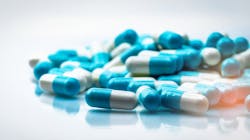Dental antibiotic prescribing rate "unchanged" in US
A recent study found that the dental antibiotic prescribing rate in the US was unchanged from 2012 through 2019—results that researchers said are “discordant with medical clinician prescribing trends.”
The study, Changes in antibiotic prescribing by dentists in the United States, 2012–2019, evaluated the change in dentist prescribing rates and mean days’ supply using linear regression models and concluded that despite decreases in antibiotic prescribing nationally and changed guidelines within that time frame, dental prescribing rates stayed the same. However, mean days’ supply decreased, a finding that “suggests that although the prescribing rate was unchanged over the study period, the days’ supply decreased and, thus, fewer doses of antibiotics prescribed by dentists circulated in the community.”
Overall, dentists prescribe 10% of all outpatient antibiotics in the US, accounting for some 216 million antibiotic prescriptions from 2012 to 2019. The majority of dentists’ prescriptions are for infection prophylaxis, 77.6% of which are discordant with US guidelines, according to the study. It goes on to state that among dentists’ other primary reasons for prescribing antibiotics, to treat acute oral infections,12%–28% of prescriptions are unnecessary.
According to the study, the average provider-based prescribing rate for all antibiotics over the entire study period was 142,155 prescriptions per 1,000 dentists per year. Amoxicillin and clindamycin were the most common antibiotics prescribed by dentists, at 62.8% and 14.2%, respectively, with the study noting that clindamycin is among the antibiotics “not commonly prescribed by other providers.”
Antibiotic prophylaxis for dental procedures: What’s the right call? notes that dentists are the top prescribers of clindamycin, the most common antibiotic leading to Clostridioides difficile (C. diff). The Michigan Antibiotic Resistance Reduction Coalition (MARR) states that due to the risk of C. diff, “Clindamycin is no longer recommended by the American Heart Association (AHA) or American Academy of Orthopaedic Surgeons (AAOS) for dental prophylaxis. For therapeutic use, the ADA recommends alternatives to clindamycin.”
While the dental antibiotic prescribing rate was unchanged during the time frame analyzed, the study noted increases in prescriptions among dentists in the Northeast. With the exception of orthodontists, the study also found “large increases” in the prescribing rate for dental specialists, particularly oral and maxillofacial surgeons, endodontists, periodontists, and prosthodontists. It’s unclear why specialists have higher rate of prescribing dental antibiotics, but potential explanations include the increased use of dental implants and worsening oral health in an aging population.
The study authors noted that while dental professionals’ antibiotics prescribing trends are discordant with medical clinician prescribing trends, "increased stewardship to improve unnecessary prescribing by dentists and targeting dental specialists and prescribing of clindamycin may decrease overall antibiotic prescribing rates by dentists."
About the Author
Elizabeth S. Leaver
Digital content manager
Elizabeth S. Leaver was the digital content manager for Endeavor Business Media's dental group from 2021-2024. She has a degree in journalism from Northeastern University in Boston and many years of experience working in niche industries specializing in creating content, editing, content marketing, and publishing digital and magazine content. She lives in the Boston area.
